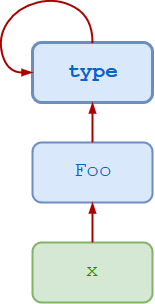Watch Now This tutorial has a related video course created by the Real Python team. Watch it together with the written tutorial to deepen your understanding: Metaclasses in Python
The term metaprogramming refers to the potential for a program to have knowledge of or manipulate itself. Python supports a form of metaprogramming for classes called metaclasses.
Metaclasses are an esoteric OOP concept, lurking behind virtually all Python code. You are using them whether you are aware of it or not. For the most part, you don’t need to be aware of it. Most Python programmers rarely, if ever, have to think about metaclasses.
When the need arises, however, Python provides a capability that not all object-oriented languages support: you can get under the hood and define custom metaclasses. The use of custom metaclasses is somewhat controversial, as suggested by the following quote from Tim Peters, the Python guru who authored the Zen of Python:
“Metaclasses are deeper magic than 99% of users should ever worry about. If you wonder whether you need them, you don’t (the people who actually need them know with certainty that they need them, and don’t need an explanation about why).”
— Tim Peters
There are Pythonistas (as Python aficionados are known) who believe that you should never use custom metaclasses. That might be going a bit far, but it is probably true that custom metaclasses mostly aren’t necessary. If it isn’t pretty obvious that a problem calls for them, then it will probably be cleaner and more readable if solved in a simpler way.
Still, understanding Python metaclasses is worthwhile, because it leads to a better understanding of the internals of Python classes in general. You never know: you may one day find yourself in one of those situations where you just know that a custom metaclass is what you want.
Get Notified: Don’t miss the follow up to this tutorial—Click here to join the Real Python Newsletter and you’ll know when the next installment comes out.
Old-Style vs. New-Style Classes
In the Python realm, a class can be one of two varieties. No official terminology has been decided on, so they are informally referred to as old-style and new-style classes.
Old-Style Classes
With old-style classes, class and type are not quite the same thing. An instance of an old-style class is always implemented from a single built-in type called instance. If obj is an instance of an old-style class, obj.__class__ designates the class, but type(obj) is always instance. The following example is taken from Python 2.7:
>>> class Foo:
... pass
...
>>> x = Foo()
>>> x.__class__
<class __main__.Foo at 0x000000000535CC48>
>>> type(x)
<type 'instance'>
New-Style Classes
New-style classes unify the concepts of class and type. If obj is an instance of a new-style class, type(obj) is the same as obj.__class__:
>>> class Foo:
... pass
>>> obj = Foo()
>>> obj.__class__
<class '__main__.Foo'>
>>> type(obj)
<class '__main__.Foo'>
>>> obj.__class__ is type(obj)
True
>>> n = 5
>>> d = { 'x' : 1, 'y' : 2 }
>>> class Foo:
... pass
...
>>> x = Foo()
>>> for obj in (n, d, x):
... print(type(obj) is obj.__class__)
...
True
True
True
Type and Class
In Python 3, all classes are new-style classes. Thus, in Python 3 it is reasonable to refer to an object’s type and its class interchangeably.
Note: In Python 2, classes are old-style by default. Prior to Python 2.2, new-style classes weren’t supported at all. From Python 2.2 onward, they can be created but must be explicitly declared as new-style.
Remember that, in Python, everything is an object. Classes are objects as well. As a result, a class must have a type. What is the type of a class?
Consider the following:
>>> class Foo:
... pass
...
>>> x = Foo()
>>> type(x)
<class '__main__.Foo'>
>>> type(Foo)
<class 'type'>
The type of x is class Foo, as you would expect. But the type of Foo, the class itself, is type. In general, the type of any new-style class is type.
The type of the built-in classes you are familiar with is also type:
>>> for t in int, float, dict, list, tuple:
... print(type(t))
...
<class 'type'>
<class 'type'>
<class 'type'>
<class 'type'>
<class 'type'>
For that matter, the type of type is type as well (yes, really):
>>> type(type)
<class 'type'>
type is a metaclass, of which classes are instances. Just as an ordinary object is an instance of a class, any new-style class in Python, and thus any class in Python 3, is an instance of the type metaclass.
In the above case:
xis an instance of classFoo.Foois an instance of thetypemetaclass.typeis also an instance of thetypemetaclass, so it is an instance of itself.

Defining a Class Dynamically
The built-in type() function, when passed one argument, returns the type of an object. For new-style classes, that is generally the same as the object’s __class__ attribute:
>>> type(3)
<class 'int'>
>>> type(['foo', 'bar', 'baz'])
<class 'list'>
>>> t = (1, 2, 3, 4, 5)
>>> type(t)
<class 'tuple'>
>>> class Foo:
... pass
...
>>> type(Foo())
<class '__main__.Foo'>
You can also call type() with three arguments—type(<name>, <bases>, <dct>):
<name>specifies the class name. This becomes the__name__attribute of the class.<bases>specifies a tuple of the base classes from which the class inherits. This becomes the__bases__attribute of the class.<dct>specifies a namespace dictionary containing definitions for the class body. This becomes the__dict__attribute of the class.
Calling type() in this manner creates a new instance of the type metaclass. In other words, it dynamically creates a new class.
In each of the following examples, the top snippet defines a class dynamically with type(), while the snippet below it defines the class the usual way, with the class statement. In each case, the two snippets are functionally equivalent.
Example 1
In this first example, the <bases> and <dct> arguments passed to type() are both empty. No inheritance from any parent class is specified, and nothing is initially placed in the namespace dictionary. This is the simplest class definition possible:
>>> Foo = type('Foo', (), {})
>>> x = Foo()
>>> x
<__main__.Foo object at 0x04CFAD50>
>>> class Foo:
... pass
...
>>> x = Foo()
>>> x
<__main__.Foo object at 0x0370AD50>
Example 2
Here, <bases> is a tuple with a single element Foo, specifying the parent class that Bar inherits from. An attribute, attr, is initially placed into the namespace dictionary:
>>> Bar = type('Bar', (Foo,), dict(attr=100))
>>> x = Bar()
>>> x.attr
100
>>> x.__class__
<class '__main__.Bar'>
>>> x.__class__.__bases__
(<class '__main__.Foo'>,)
>>> class Bar(Foo):
... attr = 100
...
>>> x = Bar()
>>> x.attr
100
>>> x.__class__
<class '__main__.Bar'>
>>> x.__class__.__bases__
(<class '__main__.Foo'>,)
Example 3
This time, <bases> is again empty. Two objects are placed into the namespace dictionary via the <dct> argument. The first is an attribute named attr and the second a function named attr_val, which becomes a method of the defined class:
>>> Foo = type(
... 'Foo',
... (),
... {
... 'attr': 100,
... 'attr_val': lambda x : x.attr
... }
... )
>>> x = Foo()
>>> x.attr
100
>>> x.attr_val()
100
>>> class Foo:
... attr = 100
... def attr_val(self):
... return self.attr
...
>>> x = Foo()
>>> x.attr
100
>>> x.attr_val()
100
Example 4
Only very simple functions can be defined with lambda in Python. In the following example, a slightly more complex function is defined externally then assigned to attr_val in the namespace dictionary via the name f:
>>> def f(obj):
... print('attr =', obj.attr)
...
>>> Foo = type(
... 'Foo',
... (),
... {
... 'attr': 100,
... 'attr_val': f
... }
... )
>>> x = Foo()
>>> x.attr
100
>>> x.attr_val()
attr = 100
>>> def f(obj):
... print('attr =', obj.attr)
...
>>> class Foo:
... attr = 100
... attr_val = f
...
>>> x = Foo()
>>> x.attr
100
>>> x.attr_val()
attr = 100
Custom Metaclasses
Consider again this well-worn example:
>>> class Foo:
... pass
...
>>> f = Foo()
The expression Foo() creates a new instance of class Foo. When the interpreter encounters Foo(), the following occurs:
-
The
__call__()method ofFoo’s parent class is called. SinceFoois a standard new-style class, its parent class is thetypemetaclass, sotype’s__call__()method is invoked. -
That
__call__()method in turn invokes the following:__new__()__init__()
If Foo does not define __new__() and __init__(), default methods are inherited from Foo’s ancestry. But if Foo does define these methods, they override those from the ancestry, which allows for customized behavior when instantiating Foo.
In the following, a custom method called new() is defined and assigned as the __new__() method for Foo:
>>> def new(cls):
... x = object.__new__(cls)
... x.attr = 100
... return x
...
>>> Foo.__new__ = new
>>> f = Foo()
>>> f.attr
100
>>> g = Foo()
>>> g.attr
100
This modifies the instantiation behavior of class Foo: each time an instance of Foo is created, by default it is initialized with an attribute called attr, which has a value of 100. (Code like this would more usually appear in the __init__() method and not typically in __new__(). This example is contrived for demonstration purposes.)
Now, as has already been reiterated, classes are objects too. Suppose you wanted to similarly customize instantiation behavior when creating a class like Foo. If you were to follow the pattern above, you’d again define a custom method and assign it as the __new__() method for the class of which Foo is an instance. Foo is an instance of the type metaclass, so the code looks something like this:
# Spoiler alert: This doesn't work!
>>> def new(cls):
... x = type.__new__(cls)
... x.attr = 100
... return x
...
>>> type.__new__ = new
Traceback (most recent call last):
File "<pyshell#77>", line 1, in <module>
type.__new__ = new
TypeError: can't set attributes of built-in/extension type 'type'
Except, as you can see, you can’t reassign the __new__() method of the type metaclass. Python doesn’t allow it.
This is probably just as well. type is the metaclass from which all new-style classes are derived. You really shouldn’t be mucking around with it anyway. But then what recourse is there, if you want to customize instantiation of a class?
One possible solution is a custom metaclass. Essentially, instead of mucking around with the type metaclass, you can define your own metaclass, which derives from type, and then you can muck around with that instead.
The first step is to define a metaclass that derives from type, as follows:
>>> class Meta(type):
... def __new__(cls, name, bases, dct):
... x = super().__new__(cls, name, bases, dct)
... x.attr = 100
... return x
...
The definition header class Meta(type): specifies that Meta derives from type. Since type is a metaclass, that makes Meta a metaclass as well.
Note that a custom __new__() method has been defined for Meta. It wasn’t possible to do that to the type metaclass directly. The __new__() method does the following:
- Delegates via
super()to the__new__()method of the parent metaclass (type) to actually create a new class - Assigns the custom attribute
attrto the class, with a value of100 - Returns the newly created class
Now the other half of the voodoo: Define a new class Foo and specify that its metaclass is the custom metaclass Meta, rather than the standard metaclass type. This is done using the metaclass keyword in the class definition as follows:
>>> class Foo(metaclass=Meta):
... pass
...
>>> Foo.attr
100
Voila! Foo has picked up the attr attribute automatically from the Meta metaclass. Of course, any other classes you define similarly will do likewise:
>>> class Bar(metaclass=Meta):
... pass
...
>>> class Qux(metaclass=Meta):
... pass
...
>>> Bar.attr, Qux.attr
(100, 100)
In the same way that a class functions as a template for the creation of objects, a metaclass functions as a template for the creation of classes. Metaclasses are sometimes referred to as class factories.
Compare the following two examples:
Object Factory:
>>> class Foo:
... def __init__(self):
... self.attr = 100
...
>>> x = Foo()
>>> x.attr
100
>>> y = Foo()
>>> y.attr
100
>>> z = Foo()
>>> z.attr
100
Class Factory:
>>> class Meta(type):
... def __init__(
... cls, name, bases, dct
... ):
... cls.attr = 100
...
>>> class X(metaclass=Meta):
... pass
...
>>> X.attr
100
>>> class Y(metaclass=Meta):
... pass
...
>>> Y.attr
100
>>> class Z(metaclass=Meta):
... pass
...
>>> Z.attr
100
Is This Really Necessary?
As simple as the above class factory example is, it is the essence of how metaclasses work. They allow customization of class instantiation.
Still, this is a lot of fuss just to bestow the custom attribute attr on each newly created class. Do you really need a metaclass just for that?
In Python, there are at least a couple other ways in which effectively the same thing can be accomplished:
Simple Inheritance:
>>> class Base:
... attr = 100
...
>>> class X(Base):
... pass
...
>>> class Y(Base):
... pass
...
>>> class Z(Base):
... pass
...
>>> X.attr
100
>>> Y.attr
100
>>> Z.attr
100
Class Decorator:
>>> def decorator(cls):
... class NewClass(cls):
... attr = 100
... return NewClass
...
>>> @decorator
... class X:
... pass
...
>>> @decorator
... class Y:
... pass
...
>>> @decorator
... class Z:
... pass
...
>>> X.attr
100
>>> Y.attr
100
>>> Z.attr
100
Conclusion
As Tim Peters suggests, metaclasses can easily veer into the realm of being a “solution in search of a problem.” It isn’t typically necessary to create custom metaclasses. If the problem at hand can be solved in a simpler way, it probably should be. Still, it is beneficial to understand metaclasses so that you understand Python classes in general and can recognize when a metaclass really is the appropriate tool to use.
Watch Now This tutorial has a related video course created by the Real Python team. Watch it together with the written tutorial to deepen your understanding: Metaclasses in Python






